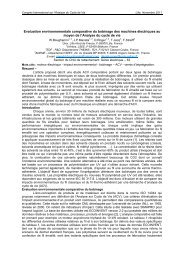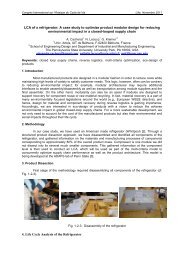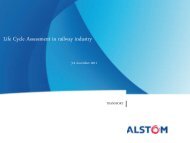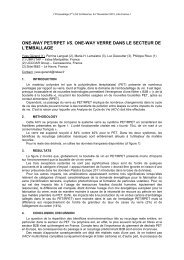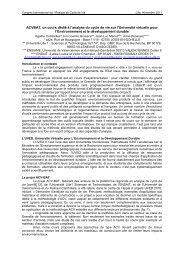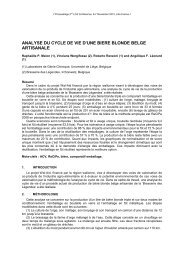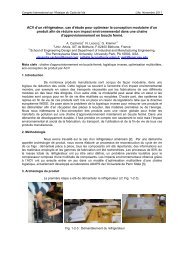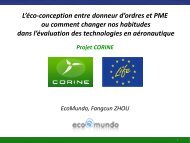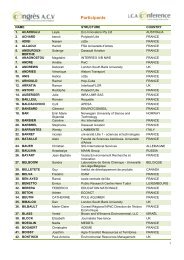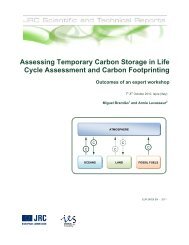Untitled - avniR
Untitled - avniR
Untitled - avniR
You also want an ePaper? Increase the reach of your titles
YUMPU automatically turns print PDFs into web optimized ePapers that Google loves.
Congrès International sur l’Analyse du Cycle de Vie Lille, Novembre 2011<br />
Development of a creativity tool to generate eco-innovations<br />
Benjamin Tyl*,**,***, Jérémy Legardeur*,**, Cyril Baldacchino***<br />
*ESTIA Recherche, Technopole IZARBEL, 64210 Bidart, France<br />
**IMS – Université Bordeaux 1, 351 Cours de la Libération, 33405 Talence, France<br />
***CRT APESA-Innovation, Technopole IZARBEL, Bidart, 64210 Bidart, France<br />
benjamin.tyl@apesa.fr; j.legardeur@estia.fr; cyril.baldacchino@apesa.fr<br />
Key words : eco-innovation ; eco-ideation ; EcoASIT<br />
1. Introduction<br />
Our planet is confronted by the deterioration of its natural environment. This deterioration is mostly<br />
due to human activities and massive manufacturing which causes great impact on the environment.<br />
Confronted with such environmental and sociological emergencies it is necessary not only to rethink our<br />
production system globally but also the ways of designing and consuming.<br />
One of our main industrial proposals was to start using eco-design based on environmental<br />
analysis tools such as Life Cycle Analysis (LCA). These tools have enabled us to obtain improved<br />
methods and so re-designing products by integrating the environmental criteria in their specifications. But<br />
these tools have rapidly become limited mostly because of their complexity of implementation and so<br />
solutions generated by them are only of a “technical” nature.<br />
The bibliographical analysis enforces three major limits in the use of eco-design [1]: (1) Current<br />
integration of these environmental design processes limits eco-design to mere superficial modifications; (2)<br />
In the global approach there is an impossibility to envisage the product out of its context.;Under evaluation<br />
in today’s process eco-design results through the user’s and the social vision of the product and (3) A<br />
technically centered vision of eco-design leads to technical results.<br />
It is essential to work on new approaches (methods, tools, organization…) which should then lead<br />
to more responsible innovation. In order to reach this goal we have developed – within the framework of a<br />
thesis with Estia Recherche laboratory, Supmeca Toulon and the Technological Resource Centre Apesa<br />
Innovation – an eco innovation tool named EcoASIT which is to encourage the generation of ecoinnovating<br />
concepts and orientate the designers towards responsible goals: the research concerning life<br />
cycle analysis, systemic and integration of sustainable development criteria (such as: behaviour, social<br />
and environment).<br />
2. EcoASIT process<br />
The EcoASIT process is adapting the ASIT creativity tool, developed by Horowitz [2]. And so,<br />
EcoASIT stimulates the group by researching the lifecycle and a global approach to the studied system.<br />
The process comprises three major phases of an iterative process : (1) the study of the limits of the<br />
system; (2) the definition of a simple and efficient aim articulated around three large axiom of sustainable<br />
development and (3) the generation of ideas specially conceived for eco innovation at stake.<br />
The first step is the reflection on the studied system with the help of “the 9 screens” tool. This tool<br />
comes from the TRIZ theory by Altshuller and aims to put the system back in the context and in the space<br />
and time frame. It helps the group to place the system studied in time (past-present-future) but also in the<br />
environment in which it is inserted (under-system/ system/ super-system). This results in the group being<br />
able to use the same language for the system studied.<br />
The second step consists in defining the aim of the session. To do so, the EcoASIT tool proposes<br />
to evaluate the system with the help of the 5 axiom diagram, then identify and organize by hierarchy the<br />
conditions leading to the current system, which is not an ideal and sustainable system. The 5 axiom<br />
correspond to 5 major problems: (1) The system consumes natural resources (water, energy, material); (2)<br />
The system generates waste and/or pollution; (3) The system is not integrated in its local environment; (4)<br />
The system is not perceived as a sustainable system; (5) The system does not correspond to usage.<br />
The evaluation of the system on these 5 axiom problems, helps not only to identify the lifecycle<br />
notion of the system but also to rapidly formalize the problem and identify the goal. The construction of the<br />
EcoASIT tool needs less effort in the formalization of the problem and therefore keeps maximum<br />
concentration available for the generation of ideas.<br />
This step is complementary to environmental analysis (LCA, simplified LCA...) made upstream<br />
which can give quantified data on environmental impacts of the system and help the group to evaluate the<br />
system on these 5 axiom. Therefore, the result of the LCA can be the starting point of the creativity session<br />
carried out with the EcoASIT tool.<br />
Finally the last step corresponds to the generation of ideas. This phase consists in generating<br />
simple sentences with objects and operators used during collective sessions such as brainstorming to<br />
41



